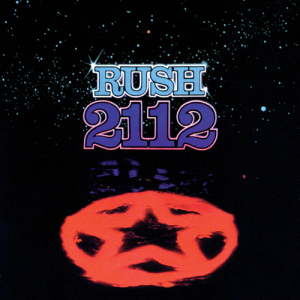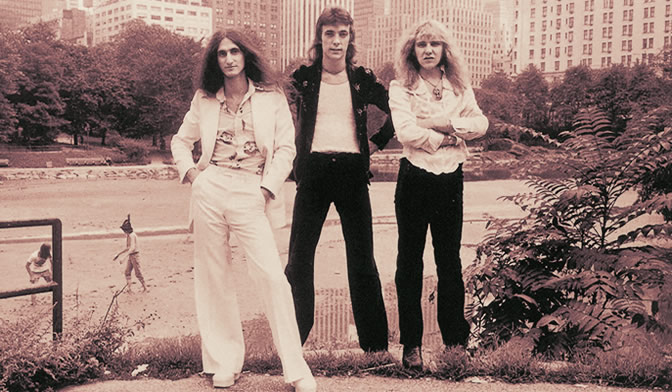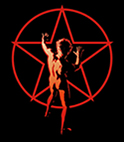2112 by Rush
 Convinced that their run at fame was all but over, the members of Rush decided to go out “in a blaze of glory”. They were all very satisfied with the previous album, 1975’s Caress of Steel and felt that the rock world just didn’t get it. Further, with sales down and exposure decreased, they resented the fact that their label, Mercury Records, seemed to be pressuring them at their most vulnerable point rather than offering the support they really needed. The label specifically did not want them to do another album with “concept” songs, such as they had with the 12-minute “The Necromancer” and the side-long epic “The Fountain of Lamneth”.
Convinced that their run at fame was all but over, the members of Rush decided to go out “in a blaze of glory”. They were all very satisfied with the previous album, 1975’s Caress of Steel and felt that the rock world just didn’t get it. Further, with sales down and exposure decreased, they resented the fact that their label, Mercury Records, seemed to be pressuring them at their most vulnerable point rather than offering the support they really needed. The label specifically did not want them to do another album with “concept” songs, such as they had with the 12-minute “The Necromancer” and the side-long epic “The Fountain of Lamneth”.
But rather than deliver some lame, commercialized album like the record company had demanded, Geddy Lee, Alex Lifeson, and Neil Peart decided to double down and make the album that THEY wanted to make as a band. They had all accepted the fact that this was probably their last best shot in the music industry and were willing to go back to life as civilians rather than have their creative instincts dictated from above. In fact, they had jocularly referred to their recent tour of clubs as the “Down the Tubes” tour.
On April 1, 1976, Rush released 2112, which indeed included a side-long eponymous concept song. But instead of choosing a pure prog rock album, the band blends a nice mix of heavy pop rock with the five standard length songs on the second side. With limited label support and little-to-no radio support, this platinum album would still go on to sell like hotcakes on the strength of word-of-mouth alone. Ironically, it would buy the band their creative independence from any future mingling by Mercury and subsequent labels. The band would be free to make whatever kind of music they wanted to make. As Neil Peart, the band’s primary lyricist said;
“It was the skeleton key that let us open that door…”
 2112 by Rush |
|
|---|---|
| Released: April 1, 1976 (Mercury) Produced by: Terry Brown & Rush Recorded: Toronto Sound Studios, February 1976 |
|
| Side One | Side Two |
| 2112 | A Passage to Bangkok The Twilight Zone Lessons Tears Something For Nothing |
| Group Musicians | |
| Geddy Lee – Bass, Synths Vocals Alex Lifeson – Guitars Neil Peart – Drums, Vocals |
|
The obvious focal point of the album is the “2112” suite that occupies the entire first side. Like he had on previous albums, Peart turned to author and philosopher Ayn Rand for inspiration, as the story closely mirrors that of her short story Anthem (ironically, the song “Anthem” off Fly By Night, while definitely inspired by Rand, was less a translation of the story by the same name). “2112” tells the dystopian story of a multi-planet society controlled the Federation of the “Red Star”, who have “no need for ancient ways” or items like the electric guitar, which is discovered by the story’s protagonist.

The seven-part suite is a cohesive and mesmerizing piece with an exciting jam, “2112 Overture”, kicking things off. Geddy Lee sings in different voices, playing the protagonist, the nemesis “priests”, and the “Oracle” – and he pulls it off fantastically, especially during the “Presentation” section of the suite. Further, the space age effects that encapsulate the whole piece give it an additional edge for appealing to the Star Wars generation of the late 1970s (even though “2112” preceded the Lucas classic by more than a year). As yet another added dimensions, there is also something a bit religious about it with the lyric “…and the meek shall inherit the earth…”, as well as the fictional society being run by “priests”. The world was ready for this type of progressive statement, that fit perfectly 1976 but yet still sounds fresh a generation and a half later.
The second side of the album is filled with standard-length, accessible pop rock songs that are each radio friendly (so, in this sense the band may have, in fact, quasi-capitulated to the record company). The side is highlighted by “A Passage to Bangkok”, a longtime fan favorite that moves from location to location on a “train” (which, at one point, mysteriously jumps the Atlantic Ocean from Bogota to Katmandu), sampling all the diverse “herb” of these native lands. “Something For Nothing”, which returns to the Randian theme on individuality, shows the band at full force to end the album on a high.
 The album’s back cover included the “Starman Logo”, which Neil Peart describes as symbolic of the individual against the masses. The logo was designed by Hugh Syme, who first worked with Rush on their cover of Caress of Steel and would be involved with most of band’s cover art in the future. Syme also played mellotron on the 2112 song “Tears”, becoming the first outside musician to make an appearance on a Rush album. That song is unique as a love song written solely by Lee, who also plays acoustic guitar on the track. Alex Lifeson also had his own fully composed song with “Lessons”, which features and upbeat blend of acoustic and electric riffs. “The Twilight Zone” is based on two episodes of the Rod Serling television show of the same name, with the lyrics based on two specific episodes; “Will the Real Martian Please Stand Up?” and “Stopover in a Quiet Town” It was the first and only single to be released from 2112.
The album’s back cover included the “Starman Logo”, which Neil Peart describes as symbolic of the individual against the masses. The logo was designed by Hugh Syme, who first worked with Rush on their cover of Caress of Steel and would be involved with most of band’s cover art in the future. Syme also played mellotron on the 2112 song “Tears”, becoming the first outside musician to make an appearance on a Rush album. That song is unique as a love song written solely by Lee, who also plays acoustic guitar on the track. Alex Lifeson also had his own fully composed song with “Lessons”, which features and upbeat blend of acoustic and electric riffs. “The Twilight Zone” is based on two episodes of the Rod Serling television show of the same name, with the lyrics based on two specific episodes; “Will the Real Martian Please Stand Up?” and “Stopover in a Quiet Town” It was the first and only single to be released from 2112.
The success of this album launched the band into their most prolific and artistically intensive period of their career. Although the longevity of Rush would see them compose even finer albums over the next several decades, 2112 remains a definitive work in the band’s history.
~
Part of Classic Rock Review’s celebration of 1976 albums.





January 12, 2020 @ 7:59 am
one of the best albums of all time. Rush was the band that band that got me off of top 40 radio garbage and showed me what music should be. thanks guy. R.I.P Neal, we will miss you.